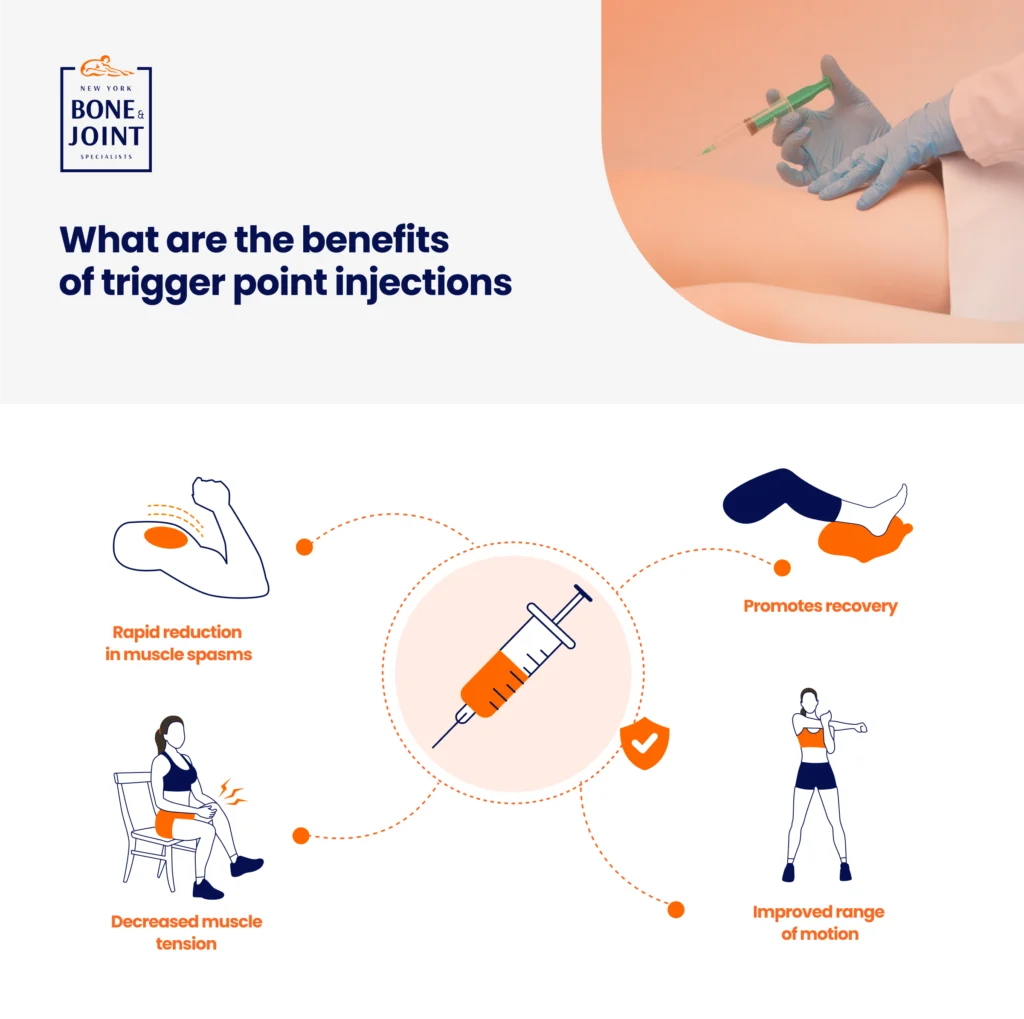Trigger point injections are a common method of alleviating tight and knotted muscles. At New York Bone and Joint Specialists, our expert orthopedic surgeons are well-versed in applying this technique to treat a range of musculoskeletal issues.
It’s completely natural to feel hesitant when hearing about trigger point injections, especially when you’re already dealing with chronic pain. Needle phobia is not uncommon.
Here’s what you should know: trigger point injections are among the most effective treatments for certain types of chronic pain, with high success rates. These minimally invasive procedures can provide immediate relief for patients who have been struggling with persistent muscle pain and tension.
Our experienced top-rated NYC orthopedists specialize in precise trigger point identification and gentle injection techniques. We prioritize your comfort throughout the entire process, taking time to explain each step and ensure you feel informed and at ease.
Don’t let fear prevent you from finding the pain relief you deserve. Read on to discover how trigger point injections could be the solution to your chronic pain challenges.
What are trigger point injections?
Trigger point injections are used to release tight “trigger points” that form within a muscle. Trigger points are characterized by a painful “knot” that forms when the fibers covering the muscle tighten up.
The injection typically contains an anesthetic and sometimes a steroid. Some trigger point injections don’t use any medications, with the doctor manipulating the affected muscle with the needle to alleviate the pain. This technique is known as dry needling.
What are trigger point injections used for?
These injections are used to help alleviate tension and pressure in the muscle by attempting to “release” the trigger point knot.
The pain caused by these tightened knots is often referred to as myofascial pain. “Myo” means muscle, while “fascial” refers to the thin, white fibers covering the muscle. The knot can be felt and is typically painful to the touch. Stiffness and limited range of motion are further symptoms of trigger points.
Myofascial pain most commonly affects muscles in the:
- Jaw
- Neck (the sides or front)
- Hip
- Low back
- Upper back and shoulders
- The sides of your head
- Buttocks
In most cases, the pain strikes the affected muscle, such as the neck or lower spine. Yet the pain may also be felt in another part of the body. For example, tightness in the trapezius muscle, which stretches from your neck to your shoulder, usually manifests as tension headaches if it contracts.
If the piriformis muscle in your buttocks tenses up and presses on your sciatic nerve, you’ll experience numbness in your buttocks and down the back of your leg.
So what triggers the myofascial pain necessitating a trigger point injection? The pain may arise from:
- Postural changes
- Trauma from injury
- Chronic muscle strains
- Psychological distress that causes inflammation
- Other health issues, such as smoking
What are the benefits of trigger point injections?
Trigger point injections are a highly effective treatment for muscle pain and tension, offering several key benefits for patients. These injections can provide immediate pain relief by releasing tight muscle knots (trigger points) that cause localized pain and referred pain to other areas.
Benefits include:
- Rapid reduction in muscle spasms
- Improved range of motion
- Decreased muscle tension,
- Can restore the ability to resume normal activities more quickly.
At New York Bone & Joint Specialists, we use trigger point injections as part of comprehensive treatment plans for conditions like chronic neck pain, back pain, headaches, and fibromyalgia, often providing relief that lasts several weeks to months.

What to expect during a trigger point injection
You may be prescribed a course of trigger point injections as part of your treatment for a muscular injury or condition. Here’s how our expert orthopedic specialists and surgeons perform trigger point injections at New York Bone & Joint Specialists.
- The doctor will mark the affected area with a marker and clean the skin around it with an alcohol wipe.
- The doctor will pinch the trigger point between their fingers. This may be a bit painful.
- A thin needle will be carefully inserted into the trigger point while the doctor massages the area. He or she will pull the needle in and out, but the needle will not be completely withdrawn.
- The muscle will spasm as the doctor performs these actions. Once the spasming has stopped, the trigger point is found and the muscle is relaxed.
- An anesthetic with or without a steroid will be injected into the trigger point.
What to expect after the trigger point injection
After the procedure, you can go home with a few restrictions. Should you experience any persistent soreness, an ice pack or pain relievers may provide relief.
What steroid is used for trigger point injections?
Commonly used steroids in trigger point injections include:
- Prednisone
- Cortisone
- Hydrocortisone.
- Methylprednisolone
- Triamcinolone
- Botulinum toxin
Only a small amount of corticosteroids is given. For the anesthetic, a mixture of Lidocaine and Marcaine may be used. These are local anesthetics that will numb the area immediately to reduce needle pain, and then relax the tight muscles of the nodule.
In more severe cases, steroids may be used on the trigger point, though it is mostly avoided since repeated use can cause tissue shrinkage and damage.
Do trigger point injections hurt?
Pain associated with trigger point injections is typically mild. Most patients experience a pinching sensation as the needle is inserted, but that soon dissipates as the anesthetic relaxes the muscle.
After the treatment, the area will feel numb for a few hours. Following that, you may be a bit sore for a day or two. Ice or over-the-counter anti-inflammatory medications, such as ibuprofen, can resolve any residual pain.
Trigger point injection side effects are rare and mild, usually ranging from bruising and minor bleeding to, in rare cases, infection. Call your doctor if you experience any lingering soreness or redness.
You can resume your normal activities after the treatment. However, avoid strenuous activity for several days.
Trigger point injections offer immediate relief, but their true value lies in enabling patients to overcome stiffness and pain. This allows them to engage in physical therapy, which further reduces discomfort and improves range of motion.
Why are we among the best New York trigger point injection doctors?
Finding a trigger point requires the practiced hands of a professional physician, like the orthopedists who work at New York Bone & Joint Specialists.
Most trigger points are often found in the skeletal muscles of the spine, so you need an experienced physician to find the trigger point and treat it effectively. Often, these nodules can be located through manual palpation; however, for deeper muscle knots, we may use ultrasound.
New York Bone and Joint Specialists is counted among the top-rated orthopedic pain management specialists in the Big Apple. Patients have been working closely with us for decades. Here’s why:
- Your muscles are crucial for a long, healthy, and active life. We prioritize their preservation and healing.
- Our world-class joint specialists offer compassionate and comprehensive care for various conditions, guiding you from diagnosis through recovery.
- Over 90% of our orthopedic cases are successfully resolved without surgery.
- We provide complete recovery for every patient through conservative treatments and, when necessary, expert surgical interventions.
Our best-rated trigger point injection specialists in NYC
New York Bone & Joint Specialists prioritizes patient well-being through a dedicated care team of physicians, surgeons, physical therapists, and support staff. We are committed to delivering outstanding care and reassurance to each patient, ensuring the long-term health and function of their joints.
Our nationally recognized pain management doctors boast extensive accreditations, published works, and industry-leading knowledge.
Make an appointment today
Start your recovery today. Book your appointment with New York Bone & Joint Specialists now.
Trigger Point Injections: FAQs
How long do trigger point injections last?
It depends. Some patients may feel complete pain relief after only one or two injections, while others may only experience partial pain reduction for several weeks before the pain returns.
More injections may be needed. In some cases, patients may require maintenance injections every three to four months.
What is the difference between a cortisone injection and a trigger point injection?
Cortisone shots are used to reduce inflammation in a specific joint, such as the knee. The injections can also treat inflamed soft tissue or nerves. In a trigger point injection, the anesthetic provides immediate pain relief, but the cortisone can relax constricted muscles longer term.
Does insurance cover the cost of trigger point injections?
Yes. But there may be a limit on the number of injections you can receive. The shots are usually done on an as-needed basis. But always check with your insurance carrier first before scheduling the treatment. The clinic staff at New York Bone & Joint Specialists can also help you with calculating your potential payments.
Are there times when a trigger point injection would not be recommended?
Before administering the trigger point injection, your doctor will rule out other conditions, such as a structural cause of the pain, like a herniated disc.
What type of doctor does trigger point injections and where do I find one near me?
Orthopedists, like the physicians at New York Bone & Joint Specialists, are qualified to perform trigger point injections to treat myofascial pain.
Check their website of orthopedic clinics near you for the services they offer, as well as the credentials of their physicians. At New York Bone & Joint Specialists, our credentialed physicians have years of experience in diagnosing and treating pain. We tailor our treatments to the individual client and the condition.
If a trigger point injection is the best treatment, we will make the procedure as painless as possible so you’ll achieve a good outcome.



